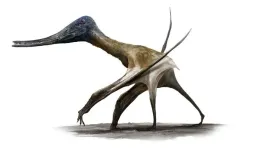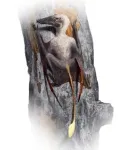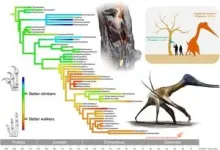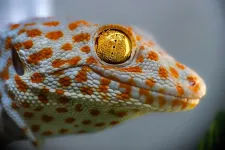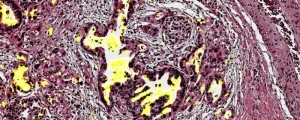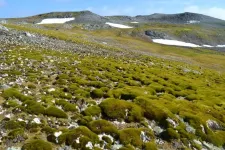(Press-News.org) The evolutionary adaptations that allowed ancient pterosaurs to grow to enormous sizes have been pinpointed for the first time by palaeontologists in the Centre for Palaeobiology and Biosphere Evolution at the University of Leicester.
The discovery revealed a surprising twist – the ability to walk efficiently on the ground played a crucial role in determining how large the biggest flying animals could grow, with some reaching wingspans of up to 10 metres.
In a new study published today (4 October) in Current Biology, a team of researchers led by the University of Leicester examined the hands and feet of pterosaurs from around the world and across their entire evolutionary history.
They uncovered a surprising level of variation similar to that seen across living birds. This discovery indicates that pterosaurs were not confined to a life in the skies but were also adapted to a wide range of terrestrial lifestyles, from tree-climbing in early species to more ground-based lifestyles in later ones.
The evolution of pterosaurs, the first true flying vertebrates, showcases some of the most remarkable adaptations in the history of life. While these creatures are best known for their ability to soar through the prehistoric skies of the Mesozoic era (252-66 million years ago), a new study has revealed a surprisingly high degree of diversity in where and how pterosaurs lived when they were not airborne.
Lead author Robert Smyth, a doctoral researcher in the in the Centre for Palaeobiology and Biosphere Evolution (School of Geography, Geology and the Environment at the University of Leicester), explained: "Early pterosaurs were highly specialised for climbing, with extreme modifications in their hands and feet, similar to those found in climbing lizards and birds like woodpeckers today. Clinging to vertical surfaces by your fingertips for long periods is hard work — it’s a lot easier for small, lightweight animals.”
These early pterosaurs were likely restricted to arboreal habitats and consequently, small body sizes. However, a major evolutionary shift occurred during the Middle Jurassic period, when pterosaur hands and feet changed to look much more like those of ground-dwelling animals. These adaptations to ground-based movement opened up new ecological opportunities, leading to a wide variety of feeding strategies. Freedom from the size constraints imposed by vertical living allowed some pterosaurs to evolve to gigantic size with wingspans of up to 10 metres.
Co-author Dr David Unwin from the University of Leicester added: "In early pterosaurs the hind limbs were connected by a flight membrane which severely impeded walking and running. In later, more advanced pterosaurs, this membrane became separated along the midline, allowing each hind limb to move independently. This was a key innovation that, combined with changes to their hands and feet, greatly improved pterosaurs’ mobility on the ground.
“Freed from the constraints of climbing, these later pterosaurs could grow to enormous sizes, with some species becoming true giants of the Mesozoic.”
The details of the hands and feet are a clear giveaway. In early pterosaurs, the bones at the base of the fingers and toes were relatively short, while those farther from the body were greatly elongated, ending in large, curved claws – together these modifications resulted in a powerful grip – ideal for climbing. By contrast, later, more advanced pterosaurs showed the opposite pattern: the bones at the base of their fingers and toes were much longer, while those closer to the tips were shorter. Their claws were also flatter and less curved, suggesting they were better adapted for walking rather than climbing.
Robert Smyth added: “These findings underscore the need to examine all aspects of pterosaur locomotion, not just flight, to fully understand their evolution. That pterosaurs could fly is only one part of their story. By exploring how they lived in the trees or on the ground, we can begin to understand the roles that they played in ancient ecosystems."
When pterosaurs arrived on the ground, it was already inhabited by a wide range of animals, including dinosaurs and many other reptiles. Pterosaurs cleverly avoided competition with these established groups by exploiting ecological niches that required both flying and walking abilities. This resulted in some bizarre feeding strategies such as evolving hundreds of fine, needle-like teeth that were used for filter-feeding. This remarkable feature, resembling the feeding method of modern flamingos, emerged at least 120 million years before the first flamingos evolved.
‘Hand and foot morphology maps invasion of terrestrial environments by pterosaurs in the mid-Mesozoic’ will be published in Current Biology, DOI: 10.1016/j.cub.2024.09.014 Link: https://doi.org/10.1016/j.cub.2024.09.014
###
Notes to editors:
Contact details
Dave Unwin
Email: dmu1@le.ac.uk
Centre for Palaeobiology and Biosphere Evolution, School of Museum Studies, University of Leicester, Leicester, LE1 7RH, UK
For further information and interview requests, please contact the University of Leicester press office on 0116 252 2160 or press@le.ac.uk
END
University of Maryland biologists identified a hidden sensory talent in geckos that’s shaking up what we thought we knew about animal hearing.
In a new study published in Current Biology on October 4, 2024, the researchers revealed that geckos use the saccule—a part of their inner ear traditionally associated with maintaining balance and body positioning—to detect low-frequency vibrations. According to the researchers, this special “sixth sense” also plays a complementary role to the geckos’ normal hearing and the way they sense ...
LONDON, Ont. and REGINA, Sask. – People who inject drugs are dying at an alarming rate from endocarditis, a serious but treatable heart-valve infection.
But their odds of survival improve dramatically, even five years after their first admission to hospital, if they’re treated not just for heart infection but are also provided with addiction support while in hospital, a Canadian study shows.
The study also highlights that women who inject drugs are particularly vulnerable to endocarditis and are affected in disproportionately high numbers.
“Endocarditis is potentially lethal and always costly,” says Dr. Michael Silverman, an infectious ...
GRAND RAPIDS, Mich. (Sept. 30, 2024) — An experimental blood test detects early-stage pancreatic cancer more effectively than other available tests, reports a new study published in Cancer Letters.
The findings pave the way for further evaluation of the test in a clinical setting, an important step toward approval as a potential diagnostic method for pancreatic cancer.
“Catching pancreatic cancer early dramatically improves survival, but our current tools for doing so are limited,” said the study’s co-corresponding author Brian Haab, Ph.D., a professor at Van Andel Institute. “Our results reveal that our combination ...
Researchers at Oxford Brookes University have pioneered a groundbreaking method to tackle one of the world’s most persistent environmental threats—toxic chemicals in global water supplies.
They have developed a new machine called a hydrodynamic reactor that uses bubbles which form and collapse due to changes in pressure, a process called cavitation. The reactor removes toxic per- and poly-fluoroalkyl substances (PFAS), also known as “forever chemicals” from water.
PFAS chemicals were invented in the 1930s and used in convenience products ...
PHILADELPHIA, Oct. 3, 2024 — Jefferson Health has been awarded $2.4 million by the Patient-Centered Outcomes Research Institute (PCORI) to implement evidence-based patient education and coaching programs for weight loss across Jefferson Primary Care.
U.S. adult obesity rates have risen to over 40% in the past two decades, increasing risks of diabetes, heart disease and premature death. Led by Baligh Yehia, M.D., MPP, MSHP, President of Jefferson Health, this project will implement sustainable health education programs ...
(WASHINGTON – October 4, 2024) In the first study to report real-world outcomes from ciltacabtagene autoleucel (cilta-cel), a chimeric antigen receptor (CAR)-T therapy for multiple myeloma, patients experienced efficacy and safety results similar to those seen in clinical trials, according to results published today in Blood.
Of 236 patients who received cilta-cel infusions at 16 U.S. medical centers in 2022, 89% saw their cancer respond to the treatment and 70% had a complete response, meaning there was no detectable cancer after the treatment. These numbers ...
A dedicated team of researchers from City University of Hong Kong (CityUHK) is pioneering cutting-edge generative artificial intelligence (GenAI) technologies on a collaborative innovation network platform, aimed at transforming science, technology and innovation (STI) services to empower research and innovation. This innovative project is set to revolutionise the related service delivery by creating a secure GenAI model and digitally transforming processes, thereby facilitating research development and technology innovation, while enhancing data security and service efficiency.
STI services, including ...
A recent position paper in the Asia-Pacific Journal of Ophthalmology explores the transformative potential of artificial intelligence (AI) in ophthalmology. Led by Lama Al-Aswad, Professor of Ophthalmology and Irene Heinz Given and John La Porte Given Research Professor of Ophthalmology II, of the Scheie Eye Institute, the work represents a collaboration among researchers from Penn Engineering, Penn Medicine, the University of Michigan Kellogg Eye Center, St. John Eye Hospital in Jerusalem, and Gyeongsang National University College of Medicine in Korea.
With fundus photography enabling the visualization ...
Vegetation cover across the Antarctic Peninsula has increased more than tenfold over the last four decades, new research shows.
The Antarctic Peninsula, like many polar regions, is warming faster than the global average, with extreme heat events in Antarctica becoming more common.
The new study – by the universities of Exeter and Hertfordshire, and the British Antarctic Survey – used satellite data to assess how much the Antarctic Peninsula has been “greening” in response to climate change.
It found that the area of vegetation ...
Every second, more than 3,000 stars are born in the visible universe. Many are surrounded by what astronomers call a protoplanetary disk – a swirling "pancake" of hot gas and dust from which planets form. The exact processes that give rise to stars and planetary systems, however, are still poorly understood.
A team of astronomers led by University of Arizona researchers has used NASA's James Webb Space Telescope to obtain some of the most detailed insights into the forces that shape protoplanetary disks. The observations offer glimpses into what our solar system may have looked like 4.6 billion years ago.
Specifically, the team was able to trace so-called ...
